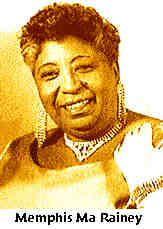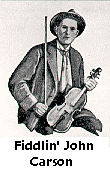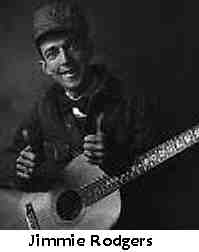
Minstrel and medicine
shows gave whites an opportunity to be introduced to and explore
the culture of blacks with the excuse of show business to fall
back on. This section describes how these shows began improving
the relationship between blacks and whites by stretching it beyond
the master and slave relationship even before the Civil War.
Minstrel shows were
musical events often featuring white performers who painted their
faces and dressed up like blacks. Beginning in the 1830s, minstrel
shows were popular all over the United States and their influence
on race relations remains ill-defined. On the one hand, they gave
many Americans their first sampling of black music1.
Whites in blackface traveled the country playing music that they
had heard performed by blacks living on plantations in the South2.
On the other hand, they operated to feed the white stereotype
of blacks. However, if it is true that imitation is the utmost
form of flattery, then these shows were evidence of white's attraction
and fondness for black culture. Francis Davis, author of The
History of the Blues, described these shows as "a world
in which black could be white, white could be black, anything
could be itself and simultaneously its opposite3."

There were many white actors in the shows who genuinely appreciated
black musical form and took pride in their authentic portrayal
of black men and women during the shows. Davis asserts that it
was these black-faced whites who eventually made it possible for
blacks to participate in the performances. The earliest black
minstrel to gain distinction was William Henry Lane. He was a
dancer in the 1840s well known for his limber moves and acclaimed
in the novel American Notes by Charles Dickens4.
Lillie Mae Glover, known as Memphis Ma Rainey, said of her travels,
"We'd go to places where they'd never seen a colored person
before. I remember once in Illinois, when we rolled into this
little town, they thought we were no-tailed bears5!"
Medicine shows were
extremely popular in America around the turn-of-the-century. Many
white country blues performers started out as  traveling songsters. Among these are
Roy Acuff, Dock Boggs, Fiddling John Carson, Frank Hutchinson,
and Uncle Dave Macon. These shows influenced race relations because
they featured and entertained blacks and whites. One of the most
famous medicine show songsters was Jimmie Rodgers, also known
as the father of hillbilly or country and western music. Rodgers's
career began in medicine shows where he occasionally put on blackface
and frequently played with Frank Stokes, a black songster of Memphis
from whom he is thought to have acquired much of his song collection.
He traveling songsters. Among these are
Roy Acuff, Dock Boggs, Fiddling John Carson, Frank Hutchinson,
and Uncle Dave Macon. These shows influenced race relations because
they featured and entertained blacks and whites. One of the most
famous medicine show songsters was Jimmie Rodgers, also known
as the father of hillbilly or country and western music. Rodgers's
career began in medicine shows where he occasionally put on blackface
and frequently played with Frank Stokes, a black songster of Memphis
from whom he is thought to have acquired much of his song collection.
He  demonstrated
his indebtedness to black music in songs such as his "Blue
Yodels." While borrowing techniques and learning from blues
artists, Rodgers was also influential to bands such as the Mississippi
Sheiks. In 1930, the Sheiks did "Yodeling, Fiddling Blues"
which could be a tribute to Rodgers6. demonstrated
his indebtedness to black music in songs such as his "Blue
Yodels." While borrowing techniques and learning from blues
artists, Rodgers was also influential to bands such as the Mississippi
Sheiks. In 1930, the Sheiks did "Yodeling, Fiddling Blues"
which could be a tribute to Rodgers6.
Like the minstrel
shows, the medicine shows often involved blackface performances
and were also a place where whites and blacks could share something
- music and entertainment. Their popularity in America began around
the turn-of-the-century and continued after the Civil War (1860-1865)
and through the Reconstruction period (1865-1877). These shows
were the birthplace of both country and blues. The emancipation
of slaves gave the black musicians, typically referred to as songsters,
the power to travel around and actually make a living playing
music. Their song collection included tunes both black and white
in origin. They played country dance pieces, minstrel songs, spirituals,
and ballads7. William Ivey of the Country Music Foundation
confirms the existence of a common repertoire between the early
country musicians and the early blues musicians forcing a type
of business relationship even at the peak of segregation8.
The noted blues historian, Robert Palmer, says "the music
of the songsters and musicians shared a number of traits with
white country music, with musicians of each race borrowing freely
from the other. But even though many white and black songs were
similar, black performing style, with its grainy vocal textures
and emphasis on rhythmic momentum, remained distinctive9."
It was this distinction that made black entertainers indispensable
and continued to cultivate white appreciation for black music.
1. Davis,
37
2. Palmer, 32
3. Davis, 37
4. Davis, 37
5. Bane, 66
6. Davis, 37
7. Palmer, 40-41
8. Bane, 83
9. Palmer, 41
 Back to top Back to top
|
